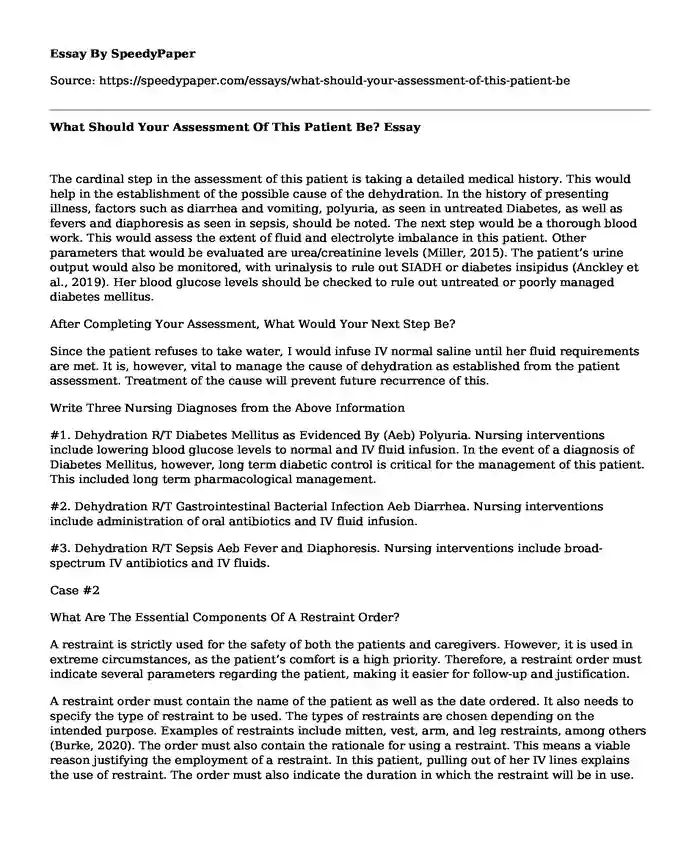The cardinal step in the assessment of this patient is taking a detailed medical history. This would help in the establishment of the possible cause of the dehydration. In the history of presenting illness, factors such as diarrhea and vomiting, polyuria, as seen in untreated Diabetes, as well as fevers and diaphoresis as seen in sepsis, should be noted. The next step would be a thorough blood work. This would assess the extent of fluid and electrolyte imbalance in this patient. Other parameters that would be evaluated are urea/creatinine levels (Miller, 2015). The patient's urine output would also be monitored, with urinalysis to rule out SIADH or diabetes insipidus (Anckley et al., 2019). Her blood glucose levels should be checked to rule out untreated or poorly managed diabetes mellitus.
After Completing Your Assessment, What Would Your Next Step Be?
Since the patient refuses to take water, I would infuse IV normal saline until her fluid requirements are met. It is, however, vital to manage the cause of dehydration as established from the patient assessment. Treatment of the cause will prevent future recurrence of this.
Write Three Nursing Diagnoses from the Above Information
#1. Dehydration R/T Diabetes Mellitus as Evidenced By (Aeb) Polyuria. Nursing interventions include lowering blood glucose levels to normal and IV fluid infusion. In the event of a diagnosis of Diabetes Mellitus, however, long term diabetic control is critical for the management of this patient. This included long term pharmacological management.
#2. Dehydration R/T Gastrointestinal Bacterial Infection Aeb Diarrhea. Nursing interventions include administration of oral antibiotics and IV fluid infusion.
#3. Dehydration R/T Sepsis Aeb Fever and Diaphoresis. Nursing interventions include broad-spectrum IV antibiotics and IV fluids.
Case #2
What Are The Essential Components Of A Restraint Order?
A restraint is strictly used for the safety of both the patients and caregivers. However, it is used in extreme circumstances, as the patient's comfort is a high priority. Therefore, a restraint order must indicate several parameters regarding the patient, making it easier for follow-up and justification.
A restraint order must contain the name of the patient as well as the date ordered. It also needs to specify the type of restraint to be used. The types of restraints are chosen depending on the intended purpose. Examples of restraints include mitten, vest, arm, and leg restraints, among others (Burke, 2020). The order must also contain the rationale for using a restraint. This means a viable reason justifying the employment of a restraint. In this patient, pulling out of her IV lines explains the use of restraint. The order must also indicate the duration in which the restraint will be in use.
Which Assessments Do You Need To Perform On Ms. Cohen While She Is Restrained?
Ms. Cohen needs to be continuously monitored for behavior changes. Changes that do not necessitate the maintenance of the restraint should be noted for discontinuation of the same. If she becomes more restless or violent, she would then need a different kind of restraint. The areas covered by the restraint, such as arms or legs, should be monitored for any signs of irritation (Miller-Hoover, 2020).
Do you continue the use of the restraint?
Since Ms. Cohen no longer manifests the previous behavior which necessitated the use of restraints, then none should be applied. However, if her behavior reverts to that of the previous day, the belt restraint should be applied.
References
Anckley, B., Ladwing, G., Flynn, M., & Martinez-Katz, M. (2019). Nursing Diagnosis Handbook (12th Edition ed.). Elsevier. Retrieved from http://repo.stikesperintis.ac.id/id/eprint/1034Burke, A. (2020). Use of Restraints and Safety Devices: NCLEX-RN. Registered Nursing Org. Retrieved from https://www.registerednursing.org/nclex/use-restraints-safety-devices/Miller, H. J. (2015). Dehydration in the Older Adult. Journal of Gerontological Nursing. Retrieved from https://www.healio.com/nursing/journals/jgn/2015-9-41-9/%7B3046aa15-d703-4e8d-832e-f1830347be31%7D/dehydration-in-the-older-adultMiller-Hoover, S. R. (2020). Safety First: The Use of Restraints. RN.COM. Retrieved from https://lms.rn.com/getpdf.php/2234.pdf
Cite this page
What Should Your Assessment Of This Patient Be?. (2023, Aug 22). Retrieved from https://speedypaper.net/essays/what-should-your-assessment-of-this-patient-be
Request Removal
If you are the original author of this essay and no longer wish to have it published on the SpeedyPaper website, please click below to request its removal:
- Free Essay on Charles Dickens' Great Expectations
- Literary Essay Sample: The Relationship in Frankenstein
- Free Essay Comprising the Full Script Analysis of Cloud 9 by Carl Churchill
- Essay Example - The Manhattan Project
- Essay Sample on Northern Renaissance and Reformation
- Essay Sample on Bob Dylan Chronicles
- Fashion Unveiled: Macro-Environment Insights, Industry Dynamics, and ASOS Resources - A Comprehensive Exploration
Popular categories





